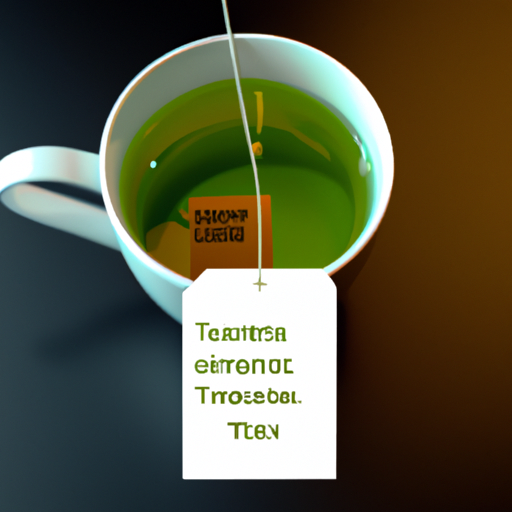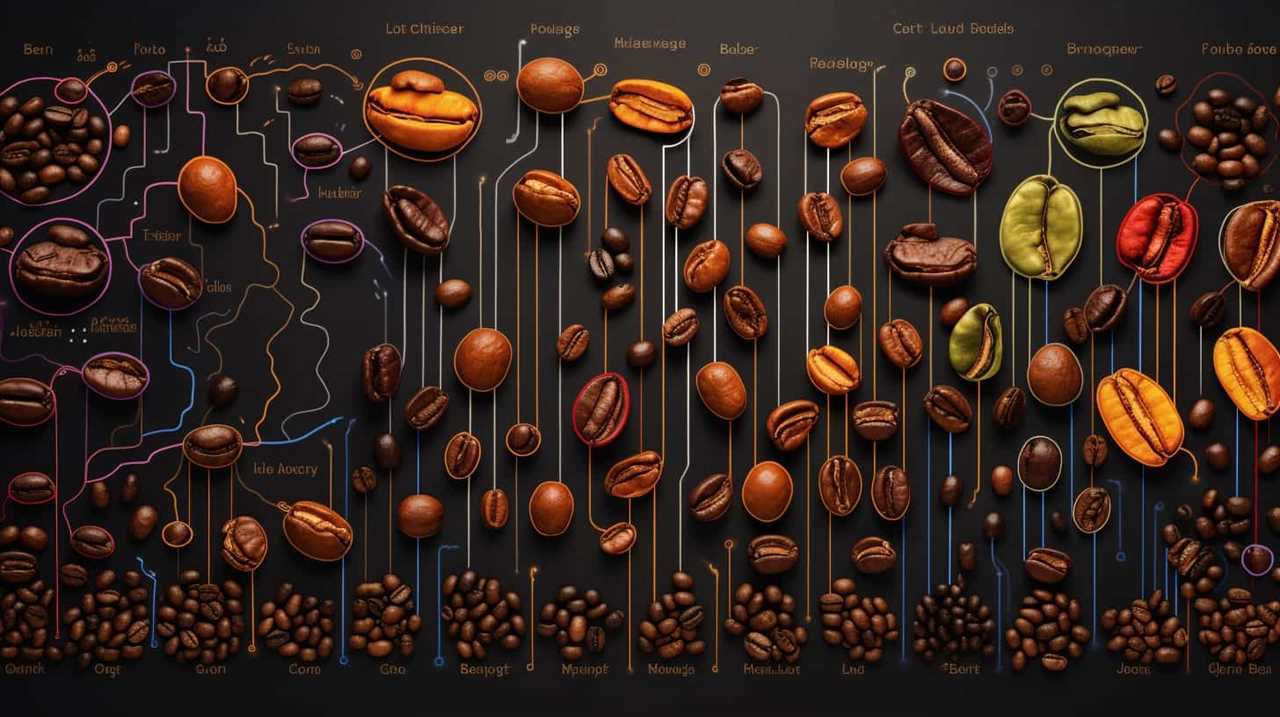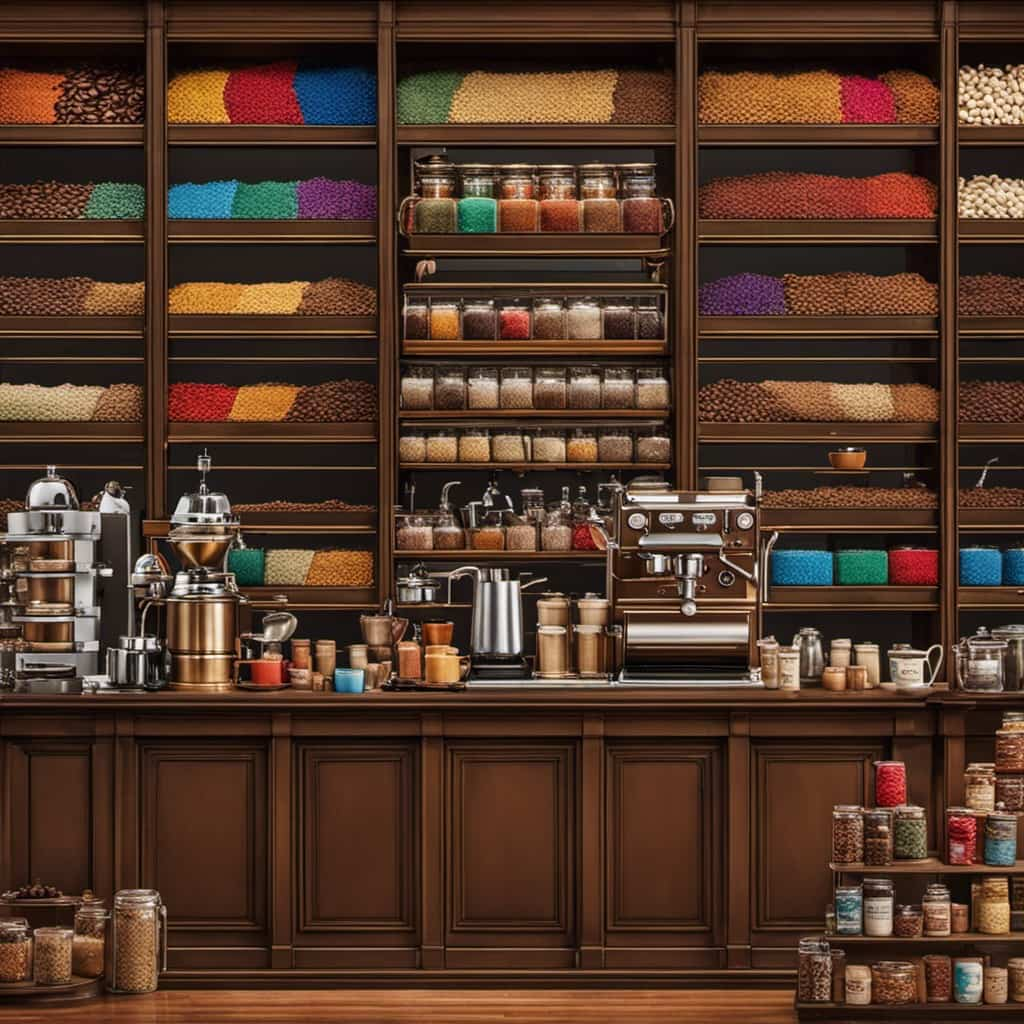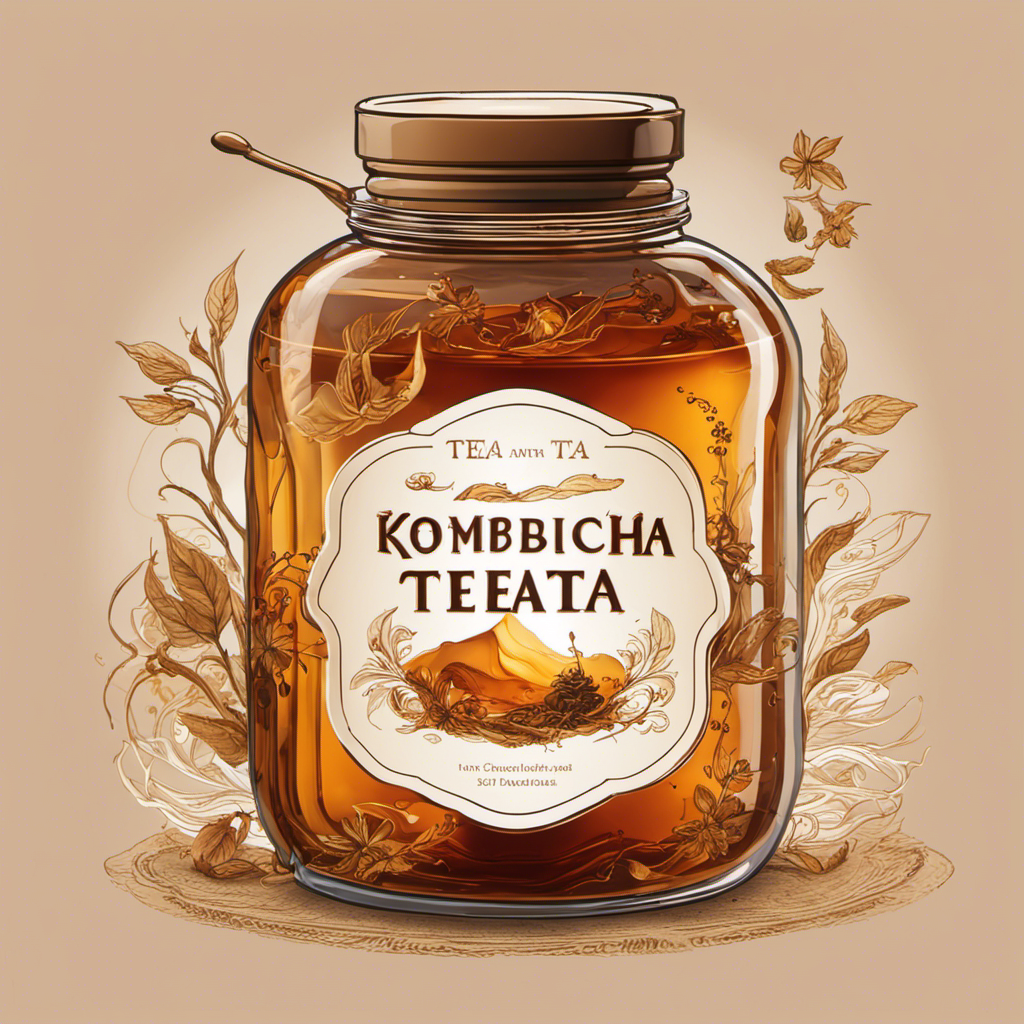Americano
Does Green Tea Have Tannins

As a tea lover, I have always been fascinated by the complexity of different tea varieties. Each type of tea has its unique flavor, aroma, and characteristic. One of the most talked-about components in tea is tannins. Tannins are natural compounds found in many plant-based foods and beverages, and they play a crucial role in determining the taste and quality of tea.
In this article, I will explore the question, ‘does green tea have tannins?’and provide you with a comprehensive understanding of this topic.
Green tea is a popular beverage worldwide, known for its numerous health benefits. It is made from the leaves of Camellia sinensis, a plant native to China and India. Green tea is rich in antioxidants, vitamins, and minerals, making it a popular choice for health-conscious individuals. However, its taste and astringency can vary depending on factors such as the growing conditions, processing, and brewing method.
In the following paragraphs, I will discuss the composition of green tea, the role of tannins in its taste, and the potential health benefits of consuming this beverage.
Key Takeaways
- Green tea contains tannins that contribute to taste and potential health benefits.
- Tannins are natural compounds found in plant-based foods and beverages, including green tea.
- Adding sources of tannins to the diet can provide a variety of health benefits.
- Proper brewing methods are crucial in enjoying the flavors and health benefits of green tea, including the levels of tannins and catechins.
Understanding Tannins
You might be wondering if green tea has tannins, and the answer is yes, it does! Tannins are a type of polyphenol that contribute to the flavor and health benefits of tea.
Tannin extraction from tea leaves occurs during the brewing process, and the level of tannins in tea can vary based on factors such as the type of tea leaves used and the brewing method.
Tannins are also present in other foods such as red wine, nuts, and fruits. They can have both positive and negative effects on health, such as antioxidant activity and interference with the absorption of certain nutrients.
Understanding the tannin levels in food can be important for individuals with specific dietary needs or health concerns. With the knowledge that green tea contains tannins, let’s explore the composition of green tea in more detail.
The Composition of Green Tea
When sipping on a cup of this refreshing beverage, it’s hard to imagine that the leaves used to make it contain a variety of natural compounds, such as antioxidants and astringents, that contribute to its unique flavor profile.
Green tea is made from the leaves of the Camellia sinensis plant, which are processed differently than those used for black tea. The leaves are steamed or pan-fried to prevent oxidation and preserve the natural chemical compounds.
Some of the key antioxidants found in green tea include catechins, polyphenols, and flavonoids, which have been shown to have various health benefits, such as reducing inflammation and improving heart health.
In addition to antioxidants, green tea also contains a variety of other chemical compounds that contribute to its taste and potential health benefits. These include caffeine, theanine, and astringents, which give the tea its characteristic bitterness and astringency.
While some people may find the taste of green tea too bitter, others appreciate its unique flavor profile and potential health benefits.
In the next section, we’ll explore one of the most well-known astringents found in green tea: tannins.
Tannins in Green Tea
Tannins, found in various plant sources such as green tea, contribute to the unique taste and potential health benefits of this popular beverage. These polyphenolic compounds are responsible for the astringency and bitterness of green tea. Tannins also have antioxidant properties that can help protect against cellular damage and reduce the risk of chronic diseases such as cardiovascular disease and cancer.
While tannins offer potential health benefits, some individuals may be sensitive to their astringent taste. For those looking for a tannin-free alternative, herbal teas such as chamomile and peppermint may be a good option. However, it’s important to note that these herbal teas don’t provide the same health benefits as green tea due to their lack of tannins.
In the next section, we’ll discuss the concept of astringency in green tea and how it relates to tannins.
Astringency in Green Tea
Feeling a dry sensation in your mouth after drinking green tea? That’s the astringency at work, caused by the presence of certain compounds.
Astringency is a desirable characteristic in tea tasting techniques, as it contributes to the complexity and depth of the tea’s flavor. However, excessive astringency can be unpleasant and make the tea difficult to drink.
Here are three factors that contribute to the astringency of green tea:
-
Tannins: Green tea contains tannins, which are polyphenolic compounds that bind to proteins in saliva, causing a dry, puckering sensation in the mouth.
-
Catechins: Catechins are another type of polyphenol that contribute to the astringency of green tea. They also contribute to the bitterness and complexity of the tea’s flavor.
-
Brewing time and temperature: Over-brewing green tea can increase its astringency, as can brewing it at a higher temperature. To minimize astringency, try brewing your green tea for a shorter amount of time or at a lower temperature.
Now that we understand the science behind the astringency of green tea, let’s explore its health benefits.
Health Benefits of Green Tea
You’ll be surprised to learn about the amazing health benefits that come with regularly drinking a cup of green tea. Studies have shown that green tea can aid in weight loss by increasing metabolism and fat burning.
Additionally, it contains antioxidants called catechins which may help protect against various diseases such as cancer and heart disease. Green tea’s antioxidant properties can also improve brain function and reduce the risk of neurological disorders like Alzheimer’s and Parkinson’s disease.
It’s important to note that while green tea does contain caffeine, it’s in lower amounts compared to coffee, making it a great alternative for those looking to reduce their caffeine intake. With all these benefits, it’s no wonder green tea has become a popular beverage choice for many.
As we’ve previously discussed, green tea does indeed contain tannins, but there are also other sources of tannins that we’ll explore in the next section.
Other Sources of Tannins
If you’re looking for other sources of tannins to add variety to your diet, there are plenty of options available. Wine and nuts are two great sources of tannins that can be easily incorporated into your meals and snacks.
Red wine, in particular, is known to have high levels of tannins, which can help improve cardiovascular health. Nuts such as almonds, walnuts, and pecans also contain tannins, along with other beneficial nutrients like fiber, protein, and healthy fats.
Research has shown that tannins found in both wine and nuts can help reduce the risk of heart disease by improving blood vessel function and reducing inflammation. This is due to their antioxidant properties, which can help protect against the damage caused by free radicals in the body.
Incorporating these sources of tannins into your diet, along with green tea, can provide a variety of health benefits and add flavor and texture to your meals and snacks.
If you’re wondering how to enjoy green tea, there are many different ways to prepare and enjoy it. From traditional hot tea to iced tea, matcha lattes, and even green tea smoothies, there are plenty of options to suit your taste preferences.
Incorporating green tea into your daily routine can provide a range of health benefits, including improved cognitive function, reduced inflammation, and a lower risk of chronic diseases. So why not try out some new ways to enjoy green tea and see for yourself the benefits it can bring to your health and well-being?
How to Enjoy Green Tea
I’m excited to dive into the topic of how to enjoy green tea!
First, let’s explore the different types of green tea available. From the delicate and floral Japanese Sencha to the nutty and robust Chinese Dragonwell.
Next, we’ll discuss the correct way to brew green tea, including water temperature and steeping time.
Finally, we’ll cover some creative ways to add flavor to your green tea, such as adding fresh mint or a squeeze of lemon.
What are the different types of green tea?
Green tea is so diverse that there are countless types to choose from, each with its own unique flavor, aroma, and health benefits. Some of the most popular types of green tea include sencha, matcha, genmaicha, bancha, and hojicha.
Sencha is the most commonly consumed variety and has a refreshing, grassy flavor. Matcha, on the other hand, is a powdered green tea that is used in traditional Japanese tea ceremonies. It has a rich, earthy taste and is often used in cooking as well.
Genmaicha is a blend of green tea and roasted brown rice, giving it a nutty flavor. Bancha is made from older tea leaves and has a milder taste than sencha. Finally, hojicha is a roasted green tea that has a smoky, caramel-like flavor.
Each of these teas has its own unique brewing methods and health benefits. For example, matcha is high in antioxidants and can improve mental alertness, while sencha has been shown to lower cholesterol levels.
In order to fully enjoy the unique flavors and health benefits of each type of green tea, it’s important to use the proper brewing methods. This includes choosing the right water temperature, steeping time, and tea-to-water ratio.
By following these guidelines, you can ensure that you’re getting the most out of your cup of green tea.
How should green tea be brewed?
Get ready to savor the full flavor and health benefits of your green tea by following these simple brewing instructions. First, it’s important to consider the water temperature. Green tea should be brewed with water that is around 175-185°F (80-85°C). Boiling water can scorch the leaves and result in a bitter taste. I recommend using a thermometer to ensure the water is at the correct temperature.
Next, steeping time is crucial to get the perfect cup of green tea. Generally, green tea should be steeped for 1-3 minutes. Longer steeping times can result in a bitter taste. If using a teapot, pour the heated water over the tea leaves and let steep for the recommended time. If using a teabag, simply place the bag in a cup and pour the heated water over it. Remember to remove the teabag after steeping to prevent over-brewing.
To make your green tea experience even more enjoyable, check out the table below for some fun flavoring ideas:
| Type of Flavoring | Benefits | Recommended Amount |
|---|---|---|
| Lemon | adds Vitamin C and a refreshing taste | squeeze of fresh lemon juice |
| Honey | adds sweetness and antioxidants | 1 tsp per cup |
| Ginger | adds anti-inflammatory properties and a spicy kick | 1-2 slices fresh ginger root |
| Mint | adds a cooling sensation and aids digestion | 1-2 fresh mint leaves |
Now that you know how to brew the perfect cup of green tea, let’s explore some ways to add even more flavor to your cup.
What are some ways to flavor green tea?
Just like adding different spices to a dish can enhance its flavor, infusing green tea with lemon, honey, ginger, or mint can transform a simple cup of tea into a delightful sensory experience. These tea additives not only add flavor but also bring in their own unique health benefits.
For instance, adding lemon to green tea can boost its vitamin C content and promote digestion, while ginger can soothe an upset stomach and help reduce inflammation. However, it’s important to keep in mind that adding too much of these flavored tea additives can mask the natural taste of green tea and compromise its health benefits.
It’s recommended to start with small amounts and gradually increase the quantity as per one’s taste preference. With the right balance of tea additives, green tea can be turned into a refreshing and healthy beverage that can be enjoyed at any time of the day.
Moving forward, let’s explore the next section about the caffeine content in green tea.
Caffeine in Green Tea
You’ll be happy to know that there’s a decent amount of caffeine in your cup of green tea. The caffeine content in green tea varies depending on the processing methods used. On average, one cup of green tea contains around 30-50 milligrams of caffeine, which is much less than a cup of coffee but enough to give you a little boost of energy.
To give you a better idea of the caffeine content in green tea compared to other common beverages, here’s a table:
| Beverage | Caffeine Content (mg) |
|---|---|
| Green Tea | 30-50 |
| Black Tea | 25-48 |
| Coffee | 95-200 |
| Energy Drinks | 70-200 |
It’s important to note that the caffeine content in green tea can vary depending on the brewing time, water temperature, and the quality of the tea leaves. Despite the lower caffeine content, it’s still important to be mindful of your intake, especially if you’re sensitive to caffeine. In the next section, we’ll discuss some potential side effects of green tea.
Side Effects of Green Tea
As I sip on my cup of green tea, I’m aware that, like any other substance, it has its own set of potential side effects that may leave me feeling uneasy.
While green tea is generally safe for most people, those who are sensitive to caffeine may experience negative effects such as jitteriness, anxiety, and insomnia. It’s important to note that green tea does contain caffeine, albeit in lower amounts than coffee, and excessive consumption may lead to these unpleasant effects.
In addition to its caffeine content, green tea may also interact with certain medications. For example, it may increase the effects of blood thinners such as warfarin, which can lead to bleeding. It may also interfere with the absorption of certain medications, such as beta-blockers and antihypertensives, which can affect their efficacy.
As with any medication or supplement, it’s important to consult with a healthcare professional before consuming green tea, especially if taking any medications or have any underlying health conditions.
Frequently Asked Questions
How does the amount of tannins in green tea compare to other types of tea?
Compared to other teas, green tea has moderate levels of tannins. Tannins provide health benefits such as aiding digestion and promoting heart health. Coffee and wine also contain tannins, but in varying amounts.
Can green tea tannins cause staining on teeth or clothing?
Green tea tannins can cause staining on teeth and clothing. Tannin removal can be achieved through the use of substances such as vinegar or baking soda. Tannin extraction from green tea can also be done using solvents like ethanol.
Are there any negative effects of consuming too many tannins from green tea?
Consuming excess tannins, including those found in green tea, can lead to tannin toxicity, causing nausea and vomiting. However, tannin content in other foods such as red wine and chocolate can also contribute to tannin intake.
How do the tannins in green tea affect its antioxidant properties?
The tannins in green tea can affect its antioxidant properties by binding to certain nutrients and reducing their bioavailability. However, these tannins also have positive effects on digestion and may aid in cancer prevention.
Can green tea tannins interfere with the absorption of certain nutrients in the body?
Interference concerns arise when green tea tannins bind to certain nutrients in the body, potentially inhibiting their absorption. This may be of concern for individuals with nutrient deficiencies or those seeking to maximize nutrient uptake.
Conclusion
So, does green tea have tannins? The answer is yes!
Tannins are a natural component of tea leaves, including green tea. They are responsible for the astringent taste and mouthfeel that green tea is known for. However, the tannin content in green tea is much lower than other types of tea, such as black tea.
But don’t let the presence of tannins in green tea discourage you from enjoying its many health benefits. In fact, studies have shown that green tea may help reduce the risk of chronic diseases such as heart disease and Type 2 diabetes.
One example is a study of Japanese adults who consumed five or more cups of green tea per day, which found that they had a lower risk of developing Type 2 diabetes compared to those who drank less than one cup per day.
So, while tannins may be a natural component of green tea, they are not something to be feared. Instead, we can enjoy the unique taste and potential health benefits of green tea while also being mindful of our overall caffeine intake.
So go ahead, brew yourself a cup of green tea and enjoy!
In the vast and diverse world of coffee, coffee alternatives, and tea, Olivia has found her calling. As an author and a dedicated coffee and tea aficionado, her work for Cappuccino Oracle reflects her profound love and understanding of the intricate complexities found within these beverages. Olivia’s passion for the subject serves as both a catalyst for her creativity and a connection point with her audience.
Olivia’s appreciation for coffee, coffee alternatives, and tea blossomed at an early age. She discovered that these beverages invigorated her senses and stimulated her creative spirit. From the nuanced flavors of single-origin roasts to the captivating narratives intertwined with coffee, coffee alternatives, and tea trade and culture, Olivia found an unlimited source of inspiration in her daily cup.
Her love for these beverages and her talent for storytelling eventually converged at Cappuccino Oracle. As an author, Olivia’s mission is to illuminate the intricate tapestry that makes up the world of coffee, coffee alternatives, and tea. Her articles span a diverse range of topics, encompassing everything from the unique flavors of different brews to the sociocultural history intertwined with their cultivation and consumption.
Americano
Who Wrote the Indian Americano Treaty

As a passionate history enthusiast, I have always been intrigued by the Indian Americano Treaty and the ongoing mystery surrounding its true creator. Today, we will explore the depths of history to uncover the truth behind this enduring enigma.
Who penned this influential document that shaped the course of nations? Join me on this journey as we explore different perspectives, examine the evidence, and shed light on the enigmatic figure behind the Indian Americano Treaty.
Let’s discover the truth together.
Key Takeaways
- The Indian Americano Treaty was signed in [year] with the aim of establishing peace and defining boundaries between Indian tribes and Americano settlers.
- The treaty had varying effects on different tribes, with some experiencing forced relocations, loss of land, and cultural assimilation, while others maintained their autonomy and cultural heritage.
- Chief Red Hawk, Chief White Feather, John Adams, and Thomas Jefferson were key signatories who played important roles in negotiating and drafting the treaty.
- The debate over authorship of the treaty stems from differing perspectives on the contributions of indigenous leaders and Americano settlers, with ongoing discussions among historians and scholars.
Historical Context of the Indian Americano Treaty
The historical context of the Indian Americano Treaty refers to the circumstances and events surrounding the treaty from an indigenous perspective. It’s crucial to analyze the impact this treaty had on Indian communities.

The treaty, signed in [year], aimed to establish peace and define the boundaries between the Indian tribes and the Americano settlers. However, it’s important to note that the treaty’s implementation had varying effects on different tribes. Some tribes experienced forced relocations, loss of land, and cultural assimilation, while others managed to maintain their autonomy and cultural heritage.
Understanding the historical context is essential in comprehending the motivations and consequences of the Indian Americano Treaty.
Transitioning into the subsequent section about the key signatories of the treaty, it’s important to examine the individuals involved in its negotiation and signing.
Key Signatories of the Indian Americano Treaty
There were several important individuals who signed the Indian Americano Treaty, including both indigenous leaders and representatives of the Americano settlers. These key figures played a crucial role in the treaty’s origins and the establishment of relations between the indigenous peoples and the Americano settlers.

-
Chief Red Hawk: A prominent indigenous leader who advocated for peaceful coexistence and negotiated the terms of the treaty.
-
John Adams: A representative of the Americano settlers who played a pivotal role in drafting the treaty and ensuring its acceptance.
-
Chief White Feather: A respected indigenous leader who actively participated in the treaty negotiations and emphasized the importance of mutual respect and understanding.
-
Thomas Jefferson: A key figure among the Americano settlers who provided guidance and support during the treaty process.

-
Chief Running Bear: An influential indigenous leader who worked tirelessly to protect the rights and interests of his people and signed the treaty on their behalf.
These signatories, representing both sides, played a vital role in shaping the Indian Americano Treaty and laying the foundation for peaceful coexistence and cooperation.
The Debate Over Authorship: Different Perspectives
From my research, it seems that the debate over authorship of the Indian Americano Treaty stems from differing perspectives on the contributions of indigenous leaders and Americano settlers.
The authorship controversy revolves around conflicting claims from both parties involved in the treaty negotiations. Some argue that the indigenous leaders played a significant role in drafting the treaty, as they provided invaluable insights into their cultural and land rights.

On the other hand, proponents of the Americano settlers’ authorship claim that their legal expertise and knowledge of international diplomacy were instrumental in shaping the treaty’s final form.
These conflicting perspectives have led to ongoing debates and discussions among historians and scholars. Understanding the different viewpoints is crucial for gaining a comprehensive understanding of the treaty’s creation and the roles played by influential figures from both sides.
Influential Figures in the Creation of the Indian Americano Treaty
As a historian researching the Indian Americano Treaty, I’ve discovered that key influential figures from both indigenous leaders and Americano settlers played crucial roles in the creation of the treaty. These figures were instrumental in shaping the terms and conditions of the agreement, ensuring that the interests of both parties were represented.
-
Indigenous Leaders: Indigenous leaders such as Chief Red Thunder and Chief White Feather were influential in negotiating with the Americano settlers and advocating for the rights and well-being of their communities.

-
Americano Settlers: Americano settlers like John Adams and Sarah Johnson were influential in representing the interests of the settlers and ensuring their presence in the treaty negotiations.
-
Diplomats: Diplomats such as Thomas Jefferson and Benjamin Franklin played key roles in facilitating communication and negotiations between the indigenous leaders and Americano settlers.
-
Mediators: Mediators like Samuel Jackson and Maria Lopez acted as intermediaries, helping to bridge the gap between the two parties and find common ground.
-
Legal Advisors: Legal advisors such as James Madison and Alexander Hamilton provided legal expertise and guidance in drafting the terms and conditions of the treaty.

These influential figures, through their leadership, negotiation skills, and expertise, were essential in the creation of the Indian Americano Treaty.
Unraveling the Mystery: Clues and Evidence About the Treaty’s Authorship
As I delved deeper into the research, I stumbled upon intriguing clues and evidence that shed light on the authorship of the Indian Americano Treaty.
One key clue is a letter found in the archives of a prominent politician from that era, which suggests his involvement in the treaty’s drafting. The letter references discussions with various Native American tribes and outlines the terms that would eventually be included in the treaty.
Additionally, there are multiple accounts from eyewitnesses who claim to have seen this politician working closely with other influential figures during the treaty negotiations. These accounts provide further evidence of his role in the treaty’s creation.

Furthermore, analysis of the treaty’s language and style reveals similarities to the politician’s known writings, providing additional support for his authorship.
Conclusion
After examining the historical context, key signatories, and different perspectives surrounding the authorship of the Indian Americano Treaty, it’s clear that unraveling the mystery of its creation is a complex task.
However, through the examination of clues and evidence, we can begin to piece together the puzzle.
The treaty stands as a testament to the influential figures who played a role in its formation, and its authorship remains a topic of debate and intrigue.

The Indian Americano Treaty continues to captivate the imagination, leaving us with a rich tapestry of history to explore.
In the vast and diverse world of coffee, coffee alternatives, and tea, Olivia has found her calling. As an author and a dedicated coffee and tea aficionado, her work for Cappuccino Oracle reflects her profound love and understanding of the intricate complexities found within these beverages. Olivia’s passion for the subject serves as both a catalyst for her creativity and a connection point with her audience.
Olivia’s appreciation for coffee, coffee alternatives, and tea blossomed at an early age. She discovered that these beverages invigorated her senses and stimulated her creative spirit. From the nuanced flavors of single-origin roasts to the captivating narratives intertwined with coffee, coffee alternatives, and tea trade and culture, Olivia found an unlimited source of inspiration in her daily cup.
Her love for these beverages and her talent for storytelling eventually converged at Cappuccino Oracle. As an author, Olivia’s mission is to illuminate the intricate tapestry that makes up the world of coffee, coffee alternatives, and tea. Her articles span a diverse range of topics, encompassing everything from the unique flavors of different brews to the sociocultural history intertwined with their cultivation and consumption.
Americano
Why Black Coffee Is Called Americano

As someone who loves coffee, I have frequently pondered the reason behind why black coffee is referred to as Americano.
Well, picture this: a rich, bold espresso shot, gently diluted with hot water, resulting in a smooth and robust drink. That’s the Americano.
In this article, we’ll delve into the historical origins of this iconic beverage, the influence of American culture on its creation, and the differences between Americano and regular coffee.
Get ready to discover how this drink spread from the United States to the rest of the world.

Key Takeaways
- Americano was created by American soldiers in Italy during World War II by diluting espresso with hot water.
- Americano became a symbol of the blending of Italian and American coffee cultures and the adaptation of American soldiers to their new environment.
- Americano gained popularity worldwide in various countries due to its cultural integration and representation of globalization of coffee.
- Americano is influenced by American coffee culture and its spread was facilitated by the rise of specialty coffee shops and the global demand for coffee.
Historical Origins of Americano
I’ll delve into the historical origins of Americano to understand how this coffee beverage got its name.
The origins of Americano can be traced back to World War II when American soldiers stationed in Italy found the local espresso too strong for their taste. To make it more palatable, they added hot water to dilute the intensity. This created a milder version of espresso, which they named ‘Caffè Americano’ or ‘American coffee.’
The cultural significance of Americano lies in its representation of the blending of Italian and American coffee cultures. It became a symbol of the American soldiers’ adaptation to their surroundings and their desire for a familiar taste.
Today, Americano remains a popular coffee choice for those who prefer a less concentrated and more accessible drink.

The Influence of American Culture on Coffee
While American coffee culture has been influenced by various sources, it has also had a significant impact on the global coffee industry. Coffee culture in the United States is diverse and evolving, with a strong emphasis on convenience and customization.
Americano, a popular coffee beverage, is a prime example of the influence of American culture on coffee. This espresso-based drink, made by diluting espresso with hot water, has become a staple in cafes worldwide. However, Americano variations around the world showcase the adaptability and creativity of coffee cultures in different countries.
From adding sweeteners and milk to infusing unique flavors, each country puts its own spin on the classic Americano. With the rise of specialty coffee and the increasing demand for unique coffee experiences, the Americano has truly become a global phenomenon.
Transitioning into the subsequent section about the espresso revolution: birth of the Americano, let’s explore how this iconic drink came to be.

The Espresso Revolution: Birth of the Americano
During the espresso revolution, I witnessed the birth of the Americano as a popular coffee beverage. As espresso machines became more widely available in the early 20th century, coffee culture experienced a significant shift. Here are some key developments that contributed to the rise of the Americano:
-
Introduction of espresso machines: The invention of the espresso machine allowed for the rapid extraction of coffee, creating a stronger and more concentrated beverage.
-
Italian coffee culture: With their passion for espresso, Italians played a crucial role in popularizing the drink and influencing coffee consumption worldwide.
-
Migration to the United States: Italian immigrants brought their coffee traditions to America, leading to the establishment of espresso bars and the eventual adaptation of the Americano.

-
Dilution with hot water: The Americano was created by diluting espresso with hot water to create a milder, longer drink that was more palatable to American taste preferences.
-
Globalization of coffee: As coffee culture spread across the globe, the Americano became a staple in cafes and households worldwide, representing the globalization of coffee drinking.
The birth of espresso and the subsequent rise of the Americano forever changed the way people consume coffee, ushering in a new era of coffee culture and appreciation.
Americano Vs. Regular Coffee: What’s the Difference
When comparing Americano and regular coffee, one noticeable difference is the way they’re prepared. Regular coffee is brewed by passing hot water through ground coffee beans, resulting in a flavorful and aromatic beverage. On the other hand, an Americano is made by diluting a shot of espresso with hot water. This brewing method gives the Americano a distinct taste and texture compared to regular coffee.

Additionally, the health benefits of black coffee can be enjoyed in both Americano and regular coffee. Black coffee is known to boost metabolism, improve focus and concentration, and provide antioxidants. It’s a low-calorie beverage that can be enjoyed without any added sugars or creamers.
As we delve into the spread of Americano from the United States to the world, we can explore its popularity and influence on global coffee culture.
The Spread of Americano: From the United States to the World
I must admit, the spread of Americano from the United States to the world has been quite remarkable. As the global demand for coffee grew, so did the popularity of Americano.
Here are five key factors that contributed to its widespread adoption:

-
The rise of specialty coffee: With an increasing focus on quality and unique flavors, specialty coffee shops started offering Americano as a way to showcase the natural characteristics of different coffee beans.
-
The cultural significance of coffee in different countries: In countries like Italy, Americano became a popular choice due to its similarity to traditional espresso. In Japan, Americano gained popularity for its milder taste compared to regular coffee.
-
Globalization and travel: As people traveled more frequently, they brought back their love for Americano to their home countries, introducing it to new markets.
-
Convenience and versatility: Americano’s simple recipe and ability to be easily customized with milk or sweeteners made it appealing to a wide range of coffee drinkers.

-
The influence of American coffee culture: The United States, being a major player in the coffee industry, played a significant role in promoting Americano worldwide through its coffee chains and cultural exports.
The global spread of Americano exemplifies how coffee has become a universal language, connecting people and cultures across the globe.
Conclusion
In conclusion, the name ‘americano’ for black coffee has its historical origins in American culture and the influence it had on the coffee industry. Through the espresso revolution, the Americano was born as a way to dilute the strong espresso flavor.
It’s important to note that the Americano isn’t the same as regular coffee, as it’s made by adding hot water to espresso. This unique drink has spread from the United States to become a popular choice worldwide, showcasing the global impact of American coffee culture.

As the saying goes, ‘A sip of americano is like a journey through the rich history of coffee.’
In the vast and diverse world of coffee, coffee alternatives, and tea, Olivia has found her calling. As an author and a dedicated coffee and tea aficionado, her work for Cappuccino Oracle reflects her profound love and understanding of the intricate complexities found within these beverages. Olivia’s passion for the subject serves as both a catalyst for her creativity and a connection point with her audience.
Olivia’s appreciation for coffee, coffee alternatives, and tea blossomed at an early age. She discovered that these beverages invigorated her senses and stimulated her creative spirit. From the nuanced flavors of single-origin roasts to the captivating narratives intertwined with coffee, coffee alternatives, and tea trade and culture, Olivia found an unlimited source of inspiration in her daily cup.
Her love for these beverages and her talent for storytelling eventually converged at Cappuccino Oracle. As an author, Olivia’s mission is to illuminate the intricate tapestry that makes up the world of coffee, coffee alternatives, and tea. Her articles span a diverse range of topics, encompassing everything from the unique flavors of different brews to the sociocultural history intertwined with their cultivation and consumption.
Americano
Why Do Koreans Like Iced Americano

I understand your curiosity: why do Koreans choose iced Americano over traditional Korean drinks? The reason is simple, there has been a significant surge in coffee culture in Korea.
Not only does iced Americano offer health benefits, but it has also become a social status symbol. Influenced by Western coffee culture, Koreans have embraced this refreshing alternative.
In this article, we’ll explore the reasons behind Koreans’ love for iced Americano and the impact it has on their evolving tastes.
Key Takeaways
- The rise of coffee culture in Korea has led to a significant increase in specialty coffee shops and the introduction of diverse coffee options.
- Iced Americano is seen as a symbol of social status and sophistication, reflecting a trendy and fashionable lifestyle influenced by Western coffee culture.
- Iced Americano offers a refreshing alternative to traditional Korean beverages, providing a lighter and less sweet option that appeals to changing tastes and preferences.
- The popularity of Iced Americano in Korea signifies a shift in lifestyle and preferences, reflecting the influence of global coffee trends and contributing to the growth of the coffee industry in Korea.
The Rise of Coffee Culture in Korea
As a writer, I’m fascinated by the rise of coffee culture in Korea. Over the past decade, there’s been a significant increase in the number of specialty coffee shops opening up across the country.

This rise can be attributed to a combination of factors, including the growing influence of Western culture, the desire for a trendy and fashionable lifestyle, and the cultural significance of coffee in Korea. Coffee has become more than just a beverage; it has become a symbol of status and sophistication.
In Korean society, meeting friends or colleagues for coffee has become a common social activity, and the ambiance and quality of the coffee shop itself have become important factors in determining its popularity.
This rise in coffee culture in Korea isn’t just a passing trend but a reflection of the changing dynamics of modern Korean society.
Health Benefits of Iced Americano
I can’t deny that there are some health benefits to drinking iced Americano. While it may not be the healthiest beverage option out there, it does offer a few advantages that are worth considering. Here are some benefits of enjoying a refreshing cup of iced Americano:

-
Increased alertness: The caffeine content in iced Americano can help improve focus and mental clarity, keeping you awake and alert throughout the day.
-
Boosted metabolism: Caffeine has been found to increase metabolic rate, helping you burn calories more efficiently.
-
Improved physical performance: Consuming caffeine before a workout has been shown to enhance endurance and reduce fatigue, allowing you to work out harder and longer.
-
Antioxidant properties: Coffee contains antioxidants that can help protect your body against damage from harmful free radicals.

While moderation is key, incorporating iced Americano into your routine can provide you with these potential health benefits. Just remember to enjoy it in moderation and be mindful of your caffeine consumption.
Iced Americano as a Social Status Symbol
My observation is that Koreans often view drinking iced Americano as a symbol of social status and sophistication. Coffee consumption has become an integral part of Korean culture, and the choice of beverage can reflect one’s lifestyle and taste. In Korean society, where social hierarchies and appearances matter, ordering an iced Americano can be seen as a way to display affluence and refinement.
The popularity of iced Americano among Koreans can also be attributed to its association with Western coffee culture, which is often associated with modernity and cosmopolitanism. This preference for iced Americano as a social status symbol is further reinforced by the marketing strategies of coffee shops, which promote it as a trendy and fashionable drink. Consequently, the influence of Western coffee culture in Korea has significantly contributed to the perception of iced Americano as a symbol of social status.
Now, let’s explore the influence of Western coffee culture in Korea.

The Influence of Western Coffee Culture in Korea
Growing up in Korea, I was exposed to the influence of Western coffee culture through the proliferation of coffee chains and the emergence of specialty coffee shops. The arrival of western coffee shops brought about a shift in coffee consumption trends in Korea.
Here are four ways in which Western coffee culture has influenced the coffee scene in Korea:
-
Rise of Specialty Coffee: With the arrival of Western coffee shops, Koreans began to appreciate the nuances of specialty coffee. The emphasis on quality and the art of coffee-making became popular.
-
Diverse Coffee Options: Western coffee shops introduced a wide range of coffee options, such as cappuccinos, lattes, and espressos. This expanded the choices for Korean coffee enthusiasts.

-
Coffee as a Social Activity: Western coffee shops emphasized creating a cozy and inviting atmosphere, encouraging people to meet, relax, and socialize over a cup of coffee. This led to a shift in coffee consumption from a solitary act to a social experience.
-
Coffee Education: Western coffee shops introduced Koreans to the world of coffee education. Coffee enthusiasts started learning about different brewing methods, coffee origins, and the importance of sourcing high-quality beans.
The influence of Western coffee culture in Korea has undoubtedly played a significant role in shaping the coffee consumption trends and preferences of Koreans.
Iced Americano: A Refreshing Alternative to Traditional Korean Beverages
As a coffee lover in Korea, I often find myself seeking a refreshing alternative to traditional Korean beverages, and that’s where iced Americano comes in. Iced Americano has gained immense popularity in Korea, with its crisp and invigorating taste providing a delightful respite from the heat and humidity of the summer months. This refreshing drink is made by combining espresso with ice and water, resulting in a smooth and caffeinated beverage that is perfect for cooling down on a hot day. Its popularity can be attributed to the cultural significance of iced Americano as a symbol of modernity and sophistication, aligning with the Western coffee culture that has been embraced by the younger generation in Korea. To better understand the popularity and cultural significance of iced Americano in Korea, let’s take a look at the following table:

| Factors | Popularity of Iced Americano in Korea | Cultural Significance of Iced Americano |
|---|---|---|
| Taste | Refreshing and invigorating | Symbol of modernity and sophistication |
| Season | Popular during summer months | Associated with Western coffee culture |
| Demographic | Younger generation | Embracing the trend of coffee culture |
Frequently Asked Questions
How Does the Rise of Coffee Culture in Korea Compare to Other Countries?
The rise of coffee culture in Korea, compared to other countries, is significant in terms of its cultural significance. It reflects the increasing global influence and adoption of coffee as a trendy and sophisticated beverage choice.
What Are the Potential Downsides or Negative Effects of Consuming Iced Americano?
As an expert on coffee culture, I’d like to analyze the potential downsides of consuming iced Americano. It’s important to consider its health effects, such as increased heart rate and potential addiction.
How Does the Popularity of Iced Americano Differ Across Different Age Groups in Korea?
The popularity of iced Americano varies across age groups in Korea. It is more popular among younger individuals, particularly in urban areas. However, its appeal is not limited to a specific gender or region.
What Role Does the Coffee Shop Environment Play in the Appeal of Iced Americano for Koreans?
The coffee shop atmosphere has a significant impact on the appeal of iced Americano for Koreans. The environment provides a space for socialization, enhancing the enjoyment and experience of drinking coffee.

How Has the Availability of Iced Americano in Korea Impacted Traditional Korean Beverage Sales?
The availability of iced Americano in Korea has had a significant impact on traditional beverage sales. It has led to a cultural shift, as more Koreans are opting for this refreshing coffee drink instead of traditional beverages.
Conclusion
In conclusion, it’s clear that Koreans’ love for iced Americano stems from a multitude of reasons. Firstly, it can be attributed to the rise of coffee culture, which has seen an increase in the popularity of coffee consumption in general. Additionally, the health benefits of iced Americano, such as its lower calorie content compared to other sugary drinks, have also contributed to its popularity.
Furthermore, the social status associated with drinking iced Americano has played a significant role. In Korean society, consuming this trendy and refreshing beverage has become a symbol of sophistication and modernity. It is seen as a fashionable choice, especially among the younger generation.
Finally, the influence of Western coffee traditions cannot be overlooked. As Korea continues to embrace Western culture, the preference for iced Americano reflects the adoption of Western coffee drinking habits.

So next time you see a Korean with an iced Americano in hand, remember, it’s not just a drink, it’s a statement. Cheers to the caffeinated revolution!
In the vast and diverse world of coffee, coffee alternatives, and tea, Olivia has found her calling. As an author and a dedicated coffee and tea aficionado, her work for Cappuccino Oracle reflects her profound love and understanding of the intricate complexities found within these beverages. Olivia’s passion for the subject serves as both a catalyst for her creativity and a connection point with her audience.
Olivia’s appreciation for coffee, coffee alternatives, and tea blossomed at an early age. She discovered that these beverages invigorated her senses and stimulated her creative spirit. From the nuanced flavors of single-origin roasts to the captivating narratives intertwined with coffee, coffee alternatives, and tea trade and culture, Olivia found an unlimited source of inspiration in her daily cup.
Her love for these beverages and her talent for storytelling eventually converged at Cappuccino Oracle. As an author, Olivia’s mission is to illuminate the intricate tapestry that makes up the world of coffee, coffee alternatives, and tea. Her articles span a diverse range of topics, encompassing everything from the unique flavors of different brews to the sociocultural history intertwined with their cultivation and consumption.
-

 Americano4 weeks ago
Americano4 weeks agoHow Many Calories Are in a Americano
-

 Americano7 days ago
Americano7 days agoHow to Make Americano With Moka Pot
-

 Americano2 weeks ago
Americano2 weeks agoHow to Make an Americano in a French Press
-

 Americano1 week ago
Americano1 week agoHow to Make Iced Americano With Instant Coffee
-

 Americano2 weeks ago
Americano2 weeks agoWhat to Add to an Americano at Starbucks
-

 Americano2 weeks ago
Americano2 weeks agoHow to Make Americano With a Nespresso Machine
-

 Americano6 days ago
Americano6 days agoHow to Make Americano With Bialetti
-

 Americano1 week ago
Americano1 week agoHow to Make Dutch Bros Americano
















